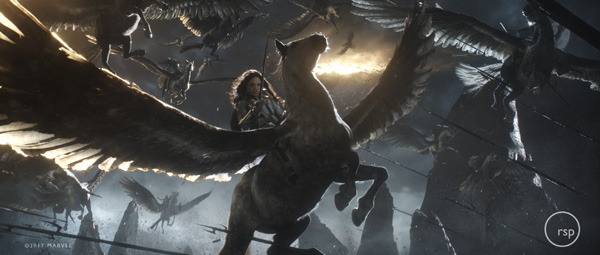
Teams at Rising Sun Pictures and Fin Design + Effects created exciting sequences, VFX and animation for Marvel's 'Thor: Ragnarok', spanning heaven and earth, distant planets and dream worlds.
Rising Sun Pictures produced more than 170 final visual effects shots for 'Thor: Ragnarok', spending about 18 months focussing on two of the film's challenging battle sequences and developing the look of the Bifröst Bridge, the magic rainbow that links the realms of the Norse universe. RSP's team worked with director Taika Waititi and production visual effects supervisor Jake Morrison. Almost 200 artists took part in the project at RSP, led by their senior visual effects supervisor Tom Wood.
Digital Media World had a chance to speak to the team's 2D Lead Jess Burnheim and CG supervisor Hubert Maston about their work on this project.
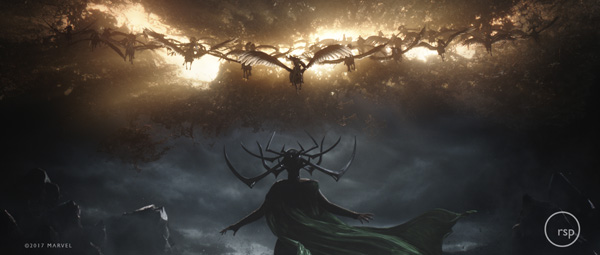
In the most complex of their two sequences, known as 'Val’s Flashback', a grand scale battle plays out in slow motion between the villain of the story Hela, Goddess of Death, who is threatening the safety of Asgard, and a huge army of Valkyrie, female warriors on winged horses. The team started working on the scene in early 2016 during pre-production. The fact that it was a standalone piece and a significant scene in the movie added to the challenge – as well as the production's expectation that it look different and like nothing that had ever been seen before.
Essential Pre-vis
RSP's experience in creating slow motion scenes for Quicksilver in 'X-Men: Days of Future Past' and 'X-Men: Apocalypse' gave them an edge as they started work on the Val's Flashback sequence. The director and production VFX supervisor Jake Morrison had created concepts for an elaborate, fantasy sequence. This fact, as well as several factors in the production, made it critical to break down the components of each shot into many layers and carry out comprehensive 3D pre-visualisation.
This previs helped to keep control over all aspects of the scenes and covered every element of the sequence to serve as a guide for production and post. Each of the 12 element layers was to be shot as a separate plate, before carefully reassembling all of them in post.
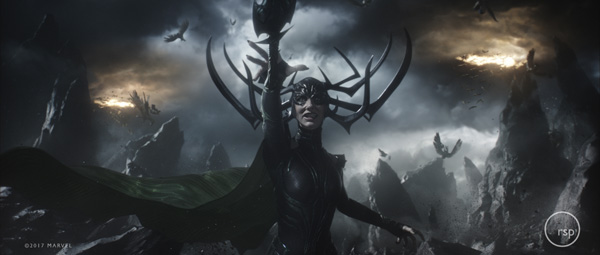
At the shoot, the live action performances were captured on a sound stage at 900 fps with a Phantom camera to achieve the slow motion effects, and a large rotating light rig was used on the set to give the scene a heroic, other-worldly look with moving patterns of lights and shadows.
“The pre-vis was also used to assist story design,” said Hubert Maston. “In the film, the sequence plays out as a story-within-a-story, and with control over a large variety of separate digital and live action elements, production could define their story in some detail right up until the shoot.
On-set supervision was critical as well. RSP's on-set team travelled to the studio in Queensland where production took place, led by their on-set visual effects, concept and pre-vis supervisor Adam Paschke to collect practical data, camera specifications, measurements and reference photography and give technical advice during the shoot. Their work supported the months of character animation, FX work and compositing that followed at RSP’s studio in Adelaide.
Heavenly Light
Jess Burnheim said, “Key aspects of the previs were the camera lensing and in particular the rotating lights. Achieving the look the director wanted was going to be quite complex, so we mapped it out in advance. That meant the lighting team were needed to help with our previs, which is unusual but in this case their guidance resulted in more accurate integration of the characters and helped with the detailed compositing we needed to do.”
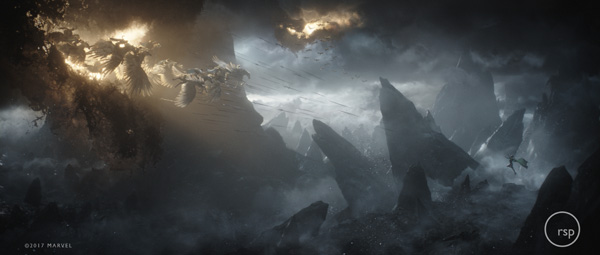
On stage, within each view, the lights on set were carefully synchronised to match the action and the previs'd lighting. Jess feels the production were pretty successful in keeping to plan. Even the actors had a specific timing and form to follow to perform in a stylised, comic-book manner. “The lighting team would need to replicate the light rig from set as well, with a CG rig to form the basis for the light in every shot,” said Hubert. “Wherever the live-action rig had produced variations between the lighting on each character and on the environment in the layers, having a CG replica of the rig helped us unify the lights in post.”
Several key shots were completed early at this stage to finalise a tone and look everyone could work toward. Jess said, “A layered hero shot was developed as a target, with eight flying horses. Riders and horses were shot first, as separate layers. Then the feathers and the horses' hair, the CG and the live action. Keeping elements on multiple environment layers also helped us build up a feeling of vastness and gave the Flashback its special atmosphere.”
Horse Feathers
The flashback sequence involved a large component of creature animation and work on digital characters, both at high-level quality across many characters in frame at once, as well as detailed work on individuals. Considerable attention went into the creation and animation of the Valkyrie warriors and in particular their horses, which often appeared close to camera.
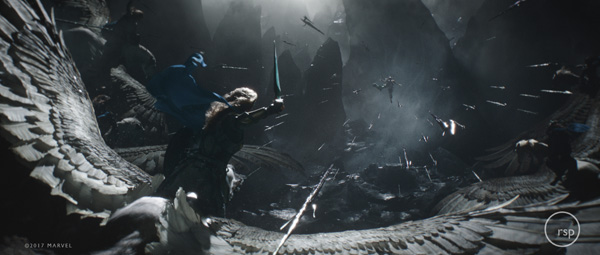
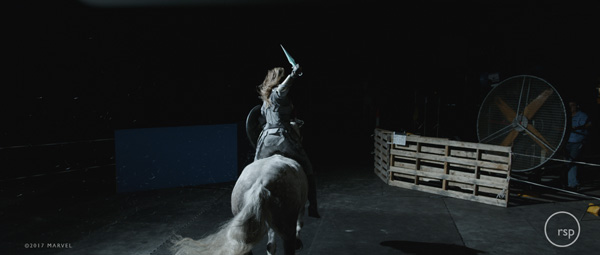
As the horses were on set for only one week, the artists needed to make the most of that time. Again, limiting each layer to only one horse and rider immediately gave them lots of control over the scene and options for visual design that they wouldn't otherwise have had.
CG horses were used to alter the live horse performances mostly because of the flying moves, which are different to moving on the ground. The creatures also had to be photo-real and look just like real horses, which viewers are naturally very familiar with, wings notwithstanding. A lot of time was spent on look development, making sure that their fur and feathers were right, and that the muscle system moved like that of a real horse.
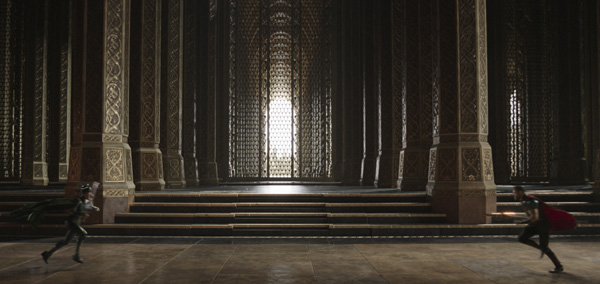
Hubert said, “Jake Morrison supplied some concepts of flying horses, which the Art Department also made into a macquette. The scale of the feathers needed consideration. What size of feathers would feel right, given that they needed to carry the horse into the air? We had to avoid letting the overall effect seem ridiculous. Feather and fur systems were key parts of the creature effects pipeline but whenever the scene involved a large number of horses, we had to prioritise the layers in the render by anticipating which horses needed a full render, and which would be far enough from the camera to do without.”
Palace Fight
The team played a major role in a dramatic battle between Hela and Thor running over about 60 shots inside the Asgard Palace. Although live action elements were shot on a practical set, the production later decided that the entire background should be replaced with a 3D environment that RSP created. The palace design followed the first film very closely but this time it needed to be larger and grander than the crew could ever have built on set. What was important for RSP's team, led by compositing lead Andrew Savchenko was making the environment believable and maintaining consistency between the different camera angles.
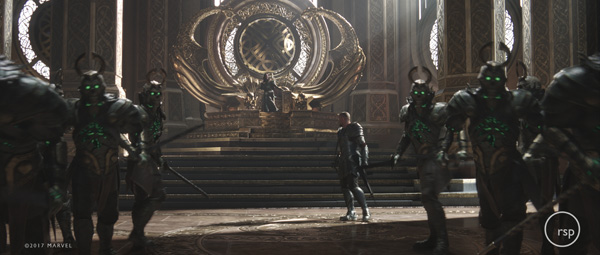
In the finished scene, Thor is the only real element kept from the plates. Jess said, “We had to extract the actor directly from the plate, without blue screen to help with keying. We literally rotoscoped everything, including his hair. It was painstaking work.”
RSP also worked on Hela’s extreme costume, which included a huge set of antlers, a cowl on on her head and a cape. But Hela is a fighter, and a costume like this was going to compromise her dramatic performance style. Instead she more often wore a full motion capture suit on set, which gave RSP a digital representation of her motion at all times. Guided by a 3D representation of her shape and moves, they could build her costume digitally, and place it accurately into any shot. In the palace sequence in particular, they occasionally needed to digitally replace her entirely depending on what was happening in the action.
The artists continued to refine the look of the costume into the later stages of production because it had to satisfy many requirements at once - staying consistent with the practical costume, the way the assets looked in the original Marvel comics, as well as accommodating the actress' performance and the action of the scene. Sometimes her moves wouldn't have been possible if she had actually been wearing the cape and antlers.
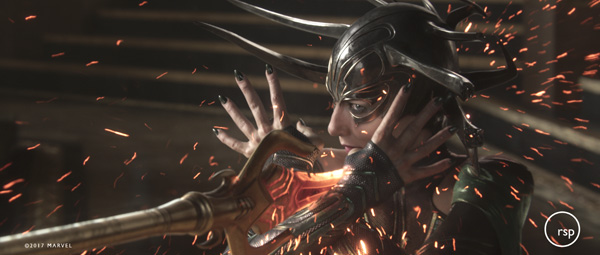
Broken Bridge
The Bifröst Bridge appears in the Palace sequence, plus another scene later on. “Its look overall needed some evolution but it still had to remain firmly rooted in the look established in the first two films. We had old reference to work from, but we had to develop the effect further,” said Jess.
“When the Bifröst is broken and reveals its mysterious composition, our team considered for some time what it was made of and what it should look like. Light was the key factor. We experimented with pools of watery light, flashes and planes of light, finally settling on a shattering glass effect.
“The Bifröst also needed to work with the plate photography. Its effects elements required relighting the scene somewhat to reflect its bright interior, including the characters, and creating some matchmoves. We also needed to watch the camera specifications – the lens affected the speed of the Bifrost animation.”
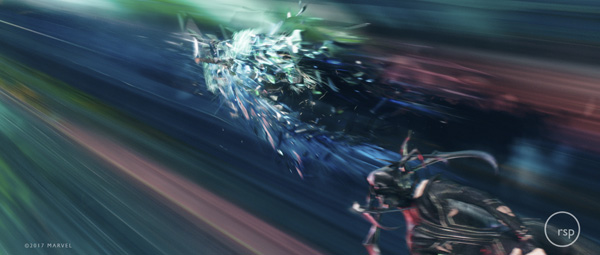
Despite the project’s complexity and the need for some last minute changes, RSP's work was able to proceed at a steady pace. Hubert remarked, “The facility’s pipeline is designed to keep all elements live and ready to accommodate last minute updates or decisions from the director and editorial. Instead of committing themselves to one version of a sequence, they are able to continuously update the assets and animation as necessary.
“This is mainly achieved through data management and keeping elements separate from one another as long as possible, and this of course, means involving the compositors during most stages, instead of only near the end.” It also means solid communication between the animation and creature departments, and a lot of sharing back-and-forth between the teams.
Journey to Grand Master
Fin Design + Effects in Sydney completed another intriguing sequence in 'Thor: Ragnarok' marking a key moment in the story by introducing a new character, Grand Master. The sequence was also used to open a 12-minute preview screening of the movie at Comic-Con in San Diego in July 2017, which the many Marvel fans at the show loved.
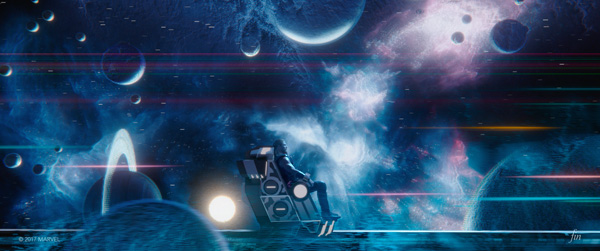
When Thor is taken prisoner on the planet Sakaar he is hauled through a dazzling induction tour explaining his new destiny as a gladiator. This time, the production only supplied footage for the foreground - Thor's performance alone, shot against bluescreen. Fin's job was to design and render a complete, intergalactic theme park-style world around him.
Led by VFX supervisor Stuart White, the team created a journey travelling from photoreal sci-fi tunnels through a holographic light show, to a ghost train ride finale. Achieving the required look and animation for the scene took advantage of the full spectrum of Fin's VFX pipeline.
Stuart White said, “We were brought in about half way through post production to help improve the storytelling at this pivotal moment in the movie. Initially, we thought that we would have a few months to develop the sequence but almost immediately, Marvel decided they would like to use it to open the 12-minute Comic-Con sneak preview clip. Suddenly, we faced a very tight eight-week schedule to get things looking pretty close to final!”
Comic Book World
The sequence takes up one minute and 15 seconds of screen time, spread over about 27 shots. Thor wakes up inside a tunnel that initially looks quite real, but very soon it spits him out into a holographic world reminiscent of a Disneyland theme park ride. The imagery becomes more and more intense and as he travels along until, totally overwhelmed, he ends up shooting down what is essentially a giant throat full of teeth.
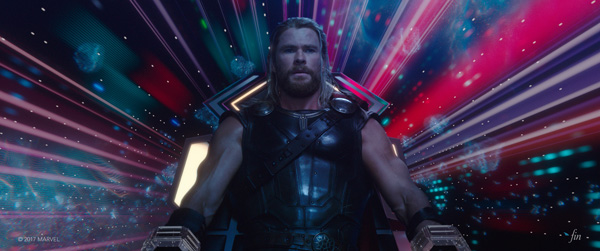
Jake Morrison told Fin's team that the planet Thor had just landed on, called Sakaar, was to contain strong visual influences from artist Jack Kirby's comic book artwork. “Chunky blocks of clashing colours, hard geometric shapes and a certain kookiness were the key features clearly evident in the Art Department's work supplied to them. So we took that as our departure point, along with comments from production about vector graphics from old arcade machines and other 1980s looks,” said Stuart. “We certainly cast a wide net looking for own visual touchstones as well. Jake referred to the psychedelic river boat ride in the original Willy Wonka movie, and we also looked at Epcot rides, tunnels under the river in Shanghai lined with lights and even 1950s horror movies.”
To get the sequence started, Marvel had completed a very rough previs, which Fin followed closely for timings as they focused on bringing a coherent 3D space and ever-increasing velocity to the journey, building it up to a satisfying crescendo. “All of our layout was done in Maya and we tried moving Thor at every speed you could imagine from walking pace to literally supersonic. The other overriding factor was Taika Waititi's insistence that the framing of all shots, looking forward or backwards, should be completely symmetrical. We ended up counting pixels to make sure Thor's chair was always right in the middle of frame!”
Not so Slick
While Thor's trip takes him rapidly through several environments, any conventional artist's notion of smoothly transitioning from one to the next was cast aside. “Smooth transitions?” Stuart laughed. “Smooth transitions aren't funny! In all seriousness, though, the unique humour that director Taika brought to this movie was such a departure from previous Thor movies that it took us a few weeks to really tune in to it.
“The quirky little kinks that stuck out in our sequence were all in there for a reason. We kept trying to make things slick, of course, but when you see the sequence as part of a larger movie, you realise that 'slick and seamless' was never the point in this part of the story - I think actor Jeff Goldblum's performance as Grand Master really latches onto that wonderful oddness that Taika brought to the world of Sakaar.
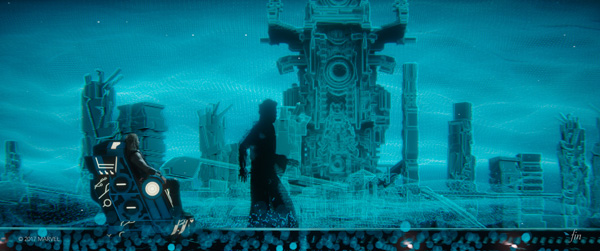
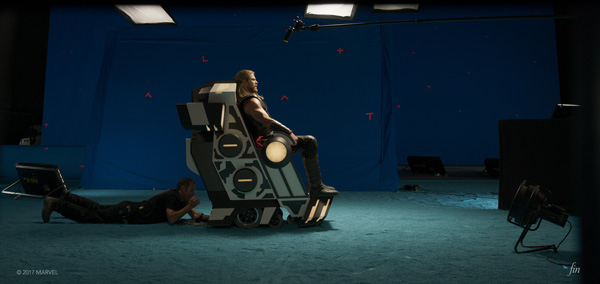
In fact, simply finding their feet and working out exactly how everything should look took up over half of their initial eight-week time frame to meet the Comic Con deadline - which left a mere three weeks to actually roll out all the shots. Ultimately though, for the film itself the team ended up spending about three to four months on the project before the last shot was finalised.
Gladiatorial Treatment
Because at the time of the shoot, production had no way of knowing how the ride experience imagery would evolve, there had been no choice but to shoot actor Chris Hemsworth in some very generic lighting, which then needed to be completely reconstructed in every shot to integrate him effectively into the middle of whatever mayhem was going on around him. Fortunately they also received some very useful 3D scans of the actor, which helped that process immensely, as did replacing the prop chair with an entirely CG one.
The team gave all of the special looks they were responsible for in this sequence a full exploration and development phase. For example, when they needed to create battling gladiators featuring rippling distortions, they decided to hold their own internal contest of champions to sort out the best approach. The gladiators went through 17 different visual treatments, some done in Maya with MASH networks, some done in Houdini. Stuart noted, “In the clash of pixels that is the Marvel review process, our lead Houdini TD Mike Thomson emerged as the victor...but at what price?
“Lead compositor Justin Bromley on the Flame was inundated with different AOVs from the Houdini render to balance as he saw fit. To maintain control through the shots, the 2D team drove a large part of the overall look by unifying not just the gladiators, but every 3D element around them with various 2D textural overlays to suggest a common alien projection technology.”
Cracking the Hologram Code
The holograms that appear in another scene were especially successful. We see Thor strapped into a CG chair, flying past planets and galaxies redesigned into holograms with a special image treatment in Flame that Justin developed, and backed up by a team of Nuke artists. Their journey to the final look and workflow is interesting.
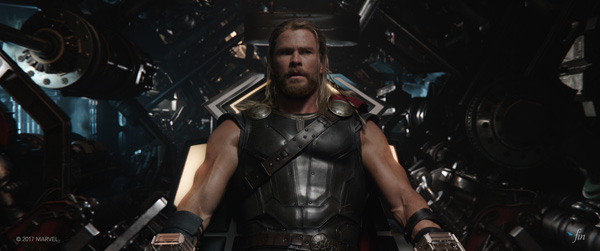
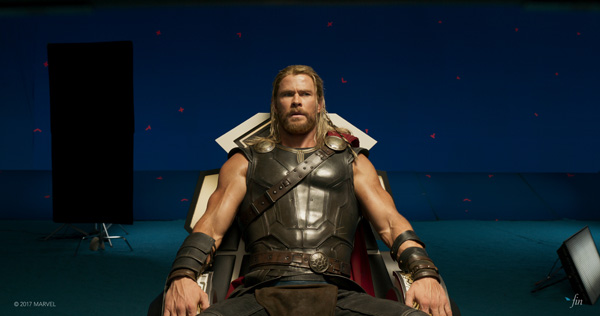
Stuart said, “The look of the holograms initially resulted from Justin's instinctive reactions to a barrage of inspirational imagery that I ran past him, which was sourced from live DJ sets, experimental volumetric hardware displays and some straightforward internet searching,” said Stuart. As lead compositor, Justin was able to experiment with the look of the holograms with a fluidity that would have been hard to match in Nuke. That agile workflow is at least part of the reason that Jake Morrison chose us for this design-heavy sequence in the first place.
“Flame was an invaluable tool in propelling the look development of the holograms through the sequence, due to its incredible speed in the hands of the right artist. Some of our staff seem to have been followed through their careers by projects needing holograms - such as 'The Hunger Games', 'Prometheus' and so on - so we had no shortage of experience. As a supervisor, it is incredibly valuable to me to be able to see literally dozens of iterations of a treatment within an hour.
“Having cracked the code and established what the holograms should look like, Justin was able to pre-render various animating textures and sections of scenery to hand off to the Nuke team to spread around their individual shots. This allowed us to rely interchangeably on the speed of Flame and the precision of Nuke throughout the shots, without feeling any visual difference between the two platforms.”
Words: Adriene Hurst
All Images © 2017 Marvel


















